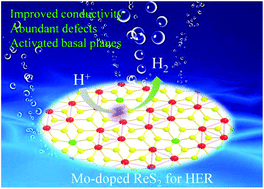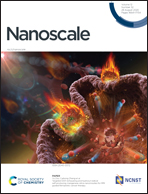Nanoscale engineering and Mo-doping of 2D ultrathin ReS2 nanosheets for remarkable electrocatalytic hydrogen generation†
Abstract
Two-dimensional (2D) lamellar ReS2 nanosheets are considered a promising electrocatalyst for the hydrogen evolution reaction (HER) but suffer from poor intrinsic conductivity and catalytically inert basal planes. In this work, sub 50 nm hierarchical Mo-doped ReS2 nanospheres consisting of numerous few-layered and defect-rich nanosheets are designed and synthesized as robust and efficient HER catalysts. On the one hand, the small size of the hierarchical structure, the disordered basal planes and the expanded interlayer endow the nanosheets with plentiful defects, thereby resulting in abundant exposed active sites. On the other hand, Mo-doping offers the nanosheets with some electronic benefits of unsaturated electrons, improved intrinsic conductivity, and optimized hydrogen adsorption free energy (ΔGH) of the basal planes. Owing to the synergistic effects, the 10%Mo-ReS2 catalyst exhibits an optimized catalytic activity with striking kinetic metrics of a small Tafel slope of 62 mV dec−1, a low overpotential of 81 mV at 10 mA cm−2, and a long operation stability of 50 h, and its performance is among the best of ReS2-based catalysts. This work provides a new approach for gaining the structural and electronic benefits of ReS2 catalysts by combinational nanoscale engineering and heteroatom doping.



 Please wait while we load your content...
Please wait while we load your content...